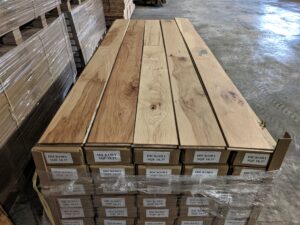The best hardwood flooring for humid climates
Posted: June 10, 2024 Author – Ryan Palma Owner/CEO Sustainable Lumber Co.
Author – Ryan Palma Owner/CEO Sustainable Lumber Co.
Choosing hardwood flooring for humid climates requires careful consideration. High humidity can damage wood, causing warping, cupping, and other issues. However, with the right type of hardwood and proper installation, you can enjoy the timeless beauty of wood flooring even in humid environments. Here is a guide to help you choose the best wood flooring for humid climates.
Click the links for pricing and details on our engineered Rustic White Oak and Rustic Hickory Flooring.
Why Humidity Matters
Humidity can cause wood to absorb moisture from the air, leading to expansion. Conversely, when the air dries out, the wood releases moisture and contracts. These fluctuations can cause significant stress on the wood, resulting in issues like:
- Cupping: Edges of the wood planks rise higher than the center.
- Buckling: Severe warping that lifts the flooring off the subfloor.
- Cracking and splitting: Caused by excessive drying.
Understanding these risks helps in selecting the most resilient wood types and installation methods, ensuring you purchase the best wood floor for a humid climate.

1. Structural Stability
Engineered Hardwood: Engineered hardwood is constructed from multiple layers of wood. The top layer, also called the wear layer, is real hardwood that is pressed and glued on top of multiple layers of plywood. This multiple-layer construction provides greater stability and resistance to moisture compared to solid hardwood. The cross-ply layers in engineered wood allow it to expand and contract in a more controlled manner, reducing the risk of warping and cupping. Choosing an engineered hardwood flooring that is at least 5/8″ thick is best for humid climates.
Solid Hardwood: Solid hardwood is a single piece of wood, making it more susceptible to the effects of humidity. Changes in moisture levels cause solid wood to expand and contract significantly more than engineered flooring, leading to potential damage.
2. Moisture Resistance
Engineered Hardwood: The plywood core of engineered hardwood is designed to withstand higher moisture levels. This makes engineered wood less likely to absorb moisture from the air, reducing the likelihood of swelling and shrinking.
Solid Hardwood: Solid hardwood absorbs moisture more readily, increasing the chances of dimensional changes and structural issues in humid conditions.
3. Installation Flexibility
Engineered hardwood: Engineered hardwood can be installed using various methods, including floating, glue-down, or nail-down techniques. This versatility allows for better accommodation of different subfloor conditions and environments, particularly in areas with high humidity.
Solid Hardwood: Solid hardwood typically requires nail-down installation, which can be less forgiving in environments where humidity levels fluctuate.
Best Types of U.S. Domestic Engineered Hardwood Floors for Humid Climates
1. Engineered Hickory
Why it Works: Hickory is the hardest domestic hardwood used for flooring according to the Janka hardness rating. Engineered Hickory’s density makes it an excellent choice for high-traffic and humid areas. Its robustness ensures long-lasting performance even in challenging environments.
2. Engineered Maple
Why it Works: Engineered Maple has a fine, consistent grain that helps it resist moisture and wear. Its hardness and durability make it suitable for high-traffic areas in humid climates. Hard Maple is the second hardest domestic hardwood according to the Janka hardness rating.
Why it Works: Oak is known for its strength and stability. Engineered Oak is less likely to warp and is a popular choice for many homes. Its dense grain structure adds to its resilience in humid conditions. White Oak is the third hardest domestic hardwood according to the Janka hardness rating.
Key Installation Tips for Humid Climates
1. Acclimation
Process: Let the engineered wood acclimate to the room’s humidity and temperature for at least 7-14 days before installation. This helps minimize the risk of expansion and attraction after installation.
2. Moisture Barriers
Use: Install a moisture barrier under the hardwood flooring. This can be felt paper or specialized underlayment designed to block moisture from seeping up from the subfloor.
3. Expansion Gaps
Importance: Leave small gaps around the perimeter of the floor to allow for natural expansion and contraction. These gaps can be covered with baseboards or trim.
4. Proper Sealing
Technique: Ensure the wood is properly sealed with a high-quality finish to protect it from moisture. Regular maintenance and resealing can prolong the life of the flooring.
Maintenance Tips
- Humidity Control: Use a dehumidifier in the Summer and a humidifier in the Winter to maintain consistent indoor humidity levels between 35%-55%.
- Regular Cleaning: Clean spills immediately to prevent moisture damage. Use a damp (not wet) mop for regular cleaning.
- Inspect Regularly: Check for signs of moisture damage, such as cupping or buckling, and address issues promptly to prevent further damage.
Conclusion
Choosing the best hardwood flooring for humid climates involves selecting the right materials and employing careful installation and maintenance practices. Engineered hardwood, particularly Oak, Maple, and Hickory, is an excellent choice for its resilience to moisture. By taking steps to control indoor humidity and protect your flooring, you can enjoy the beauty and durability of hardwood flooring even in the most challenging climates.
Our knowledgeable and educated staff is here to answer any additional questions you may have. Please call us today for a free quote: Ph# 406.642.7120 or click here to submit an inquiry online. We look forward to working with you on your next project!

